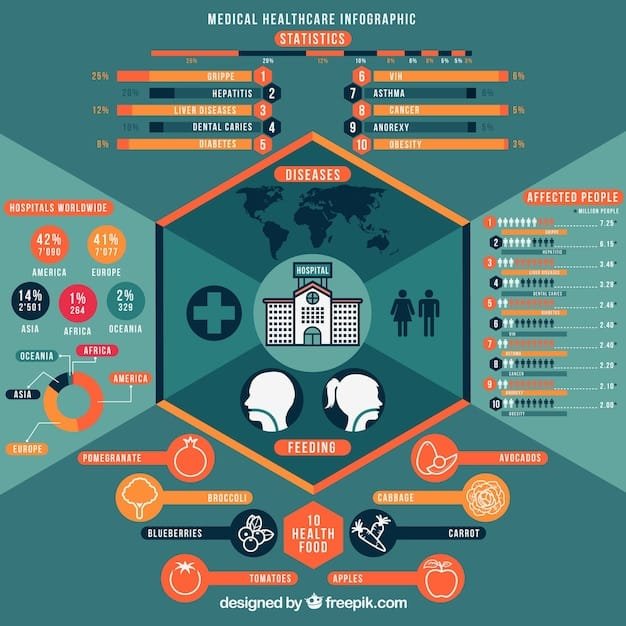Navigating Healthcare Open Enrollment: Your Guide to Choosing the Right Plan

Navigating healthcare open enrollment requires understanding plan types, assessing healthcare needs, and comparing costs to find the most suitable plan for individual and family circumstances.
Navigating healthcare open enrollment: choosing the right plan can feel overwhelming, but with careful planning and a clear understanding of your needs, you can find a health insurance plan that fits your budget and provides the coverage you need.
Understanding Healthcare Open Enrollment
Healthcare open enrollment is the designated period each year when individuals and families can enroll in or change their health insurance plans. This is the time to review your current coverage, assess your healthcare needs for the upcoming year, and explore different plan options to find the best fit.
Missing the open enrollment period can limit your options for obtaining health insurance unless you qualify for a special enrollment period due to a qualifying life event.
Key Dates for Open Enrollment
The open enrollment period for the Health Insurance Marketplace typically runs from November 1 to January 15 in most states. However, some states that operate their own marketplaces may have different deadlines. Employer-sponsored plans also have their own open enrollment periods, which usually occur in the fall.
- Marketplace Open Enrollment: Typically November 1 to January 15.
- Employer-Sponsored Plans: Usually in the fall, check with your HR department.
- Medicare Open Enrollment: October 15 to December 7.

It’s crucial to mark these dates on your calendar to ensure you don’t miss the opportunity to make informed decisions about your healthcare coverage. Taking the time to understand these deadlines can save you from being locked into a plan that doesn’t meet your needs or facing a gap in coverage.
In conclusion, understanding the healthcare open enrollment period is the first step toward securing appropriate healthcare coverage. Knowing the key dates allows you to plan ahead and explore your options without feeling rushed. Don’t wait until the last minute; start preparing early to make the best choice for your health and financial well-being.
Assessing Your Healthcare Needs
Before you start comparing health insurance plans, take some time to evaluate your healthcare needs. Consider factors such as your current health status, any chronic conditions you may have, and the healthcare services you anticipate needing in the coming year.
By understanding your healthcare needs, you can narrow down your plan options and choose a plan that offers the coverage you need at a price you can afford.
Consider Your Medical History
Review your medical history and consider any recurring healthcare needs. Do you have any chronic conditions that require regular doctor visits, medications, or specialized care? If so, you’ll want to choose a plan that provides comprehensive coverage for these services.
Estimate Your Healthcare Usage
Think about how often you typically visit the doctor, fill prescriptions, or require other healthcare services. If you anticipate needing a lot of healthcare, you may want to choose a plan with lower out-of-pocket costs, even if the monthly premium is higher. On the other hand, if you’re generally healthy and don’t anticipate needing much care, you may be able to save money by choosing a plan with a higher deductible and lower premium.
- Chronic Conditions: Regular doctor visits, medications, specialized care.
- Frequency of Healthcare Usage: Doctor visits, prescriptions, other services.
- Anticipated Healthcare Needs: Consider any planned procedures or treatments.
Assessing your healthcare needs is a critical step in choosing the right plan. By understanding your medical history and estimating your healthcare usage, you can make an informed decision that meets your individual requirements and ensures you receive the care you need when you need it.
Understanding Different Types of Health Insurance Plans
There are several different types of health insurance plans available, each with its own unique features and benefits. Understanding the differences between these plans is essential for making an informed decision about your healthcare coverage. Among the most common types are Health Maintenance Organizations (HMOs) and Preferred Provider Organizations (PPOs).
Familiarizing yourself with the characteristics of various health insurance plans will empower you to compare plans effectively and select the one that aligns best with your healthcare requirements.
Health Maintenance Organizations (HMOs)
HMOs typically require you to choose a primary care physician (PCP) who will coordinate your care and provide referrals to specialists. HMOs often have lower premiums and out-of-pocket costs, but they may offer less flexibility in terms of choosing your own doctors.
Preferred Provider Organizations (PPOs)
PPOs allow you to see any doctor or specialist without a referral, but you’ll typically pay less if you stay within the plan’s network of preferred providers. PPOs generally have higher premiums and out-of-pocket costs compared to HMOs, but they offer greater flexibility.
- HMOs: Lower premiums, PCP required for referrals, less flexibility.
- PPOs: Higher premiums, no referrals needed, more flexibility.
- EPOs: Combination of HMO and PPO, no referrals in-network, no out-of-network coverage.
Understanding the different types of health insurance plans available is crucial for making an informed decision during open enrollment. Whether you prioritize lower costs or greater flexibility, there’s a plan that can meet your needs. Take the time to research each option and choose the one that’s right for you and your family.
Comparing Costs: Premiums, Deductibles, and Coinsurance
When comparing health insurance plans, it’s important to consider not only the monthly premium but also the deductible, coinsurance, and other out-of-pocket costs. These costs can vary significantly between plans, so it’s essential to understand how they work and how they may impact your overall healthcare expenses. It’s important to look at a variety of ways a health insurance company can charge you for care.
Evaluating the total cost of a health insurance plan involves assessing premiums, deductibles, and coinsurance to determine affordability and coverage effectiveness.
Understanding Premiums
The premium is the monthly payment you make to maintain your health insurance coverage. Premiums can vary depending on the type of plan, your age, location, and other factors. While a lower premium may seem appealing, it’s important to consider the other costs associated with the plan.
Deductibles and Coinsurance
The deductible is the amount you must pay out-of-pocket before your health insurance coverage kicks in. Coinsurance is the percentage of healthcare costs you’re responsible for after you’ve met your deductible. For example, if your plan has an 80/20 coinsurance, you’ll pay 20% of the costs, and your insurance company will pay 80%.

In summary, comparing costs involves assessing premiums, deductibles, and coinsurance to find a health insurance plan that balances affordability and adequate coverage. Understanding these cost factors ensures informed decision-making during open enrollment.
Qualifying Life Events and Special Enrollment Periods
Outside of the open enrollment period, you can only enroll in or change your health insurance plan if you qualify for a special enrollment period. A special enrollment period is triggered by a qualifying life event, such as getting married, having a baby, or losing your job. Knowing what events qualify is critical.
Understanding the circumstances that qualify you for a special enrollment period allows for timely adjustments to your health insurance coverage in response to significant life changes.
Examples of Qualifying Life Events
Qualifying life events include changes in your household, such as marriage, divorce, or the birth or adoption of a child. They also include changes in your job, such as losing coverage through your employer or becoming eligible for a new employer-sponsored plan. Additionally, changes in your residence, such as moving to a new state, can also trigger a special enrollment period.
How to Enroll During a Special Enrollment Period
If you experience a qualifying life event, you typically have 60 days from the date of the event to enroll in or change your health insurance plan. You’ll need to provide documentation to verify your eligibility for a special enrollment period. This documentation may include marriage certificates, birth certificates, or proof of loss of coverage from your employer.
- Marriage or Divorce: Changes in household status.
- Birth or Adoption of a Child: Expanding your family.
- Loss of Job or Coverage: Changes in employment affecting coverage.
Understanding qualifying life events and special enrollment periods is crucial for ensuring you have access to health insurance coverage when you need it most. Knowing the circumstances that trigger a special enrollment period and how to enroll can provide peace of mind during times of transition.
Utilizing Resources and Tools for Informed Decision-Making
Navigating healthcare open enrollment can be complex, but there are numerous resources and tools available to help you make informed decisions. From government websites to insurance company resources, take advantage of these tools to compare plans, estimate costs, and understand your coverage options. Seeking advice from professionals or using online resources can greatly help.
Leveraging available resources and tools can demystify the open enrollment process, empowering you to make well-informed choices about your healthcare coverage.
Government Websites and Marketplaces
The Health Insurance Marketplace, also known as the Affordable Care Act (ACA) marketplace, provides a centralized platform for comparing health insurance plans and enrolling in coverage. Additionally, many states operate their own marketplaces, which may offer additional plan options and resources.
Insurance Company Resources
Insurance companies often provide online tools and resources to help you compare plans, estimate costs, and understand your coverage options. These resources may include plan comparison charts, cost calculators, and educational materials.
- Health Insurance Marketplace: Compare plans and enroll in coverage.
- State Marketplaces: Additional plan options and resources.
- Insurance Company Websites: Tools to compare plans and estimate costs.
In conclusion, utilizing available resources and tools is essential for making informed decisions during healthcare open enrollment. From government websites to insurance company resources, these tools can help you compare plans, estimate costs, and understand your coverage options, ultimately leading to a better healthcare choice.
| Key Aspect | Brief Description |
|---|---|
| 🗓️ Open Enrollment | Annual period to enroll in or change health plans. |
| 🩺 Healthcare Needs | Assess medical history, usage, and anticipated needs. |
| 💰 Costs | Compare premiums, deductibles, and coinsurance. |
| ❗ Life Events | Qualifying events trigger special enrollment periods. |
Frequently Asked Questions
▼
▼
▼
▼
▼
Conclusion
In summary, navigating healthcare open enrollment: choosing the right plan involves careful consideration of several factors, including understanding open enrollment periods, assessing your healthcare needs, comparing plan types and costs, and knowing how to utilize available resources. By taking a proactive approach and educating yourself about your options, you can confidently select a health insurance plan that provides the coverage you need at a price you can afford, ensuring peace of mind for you and your family.





